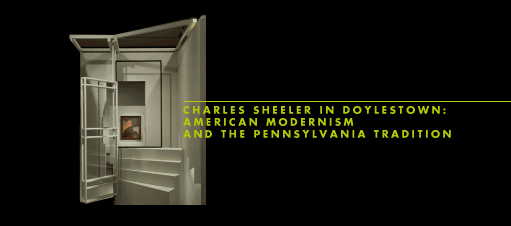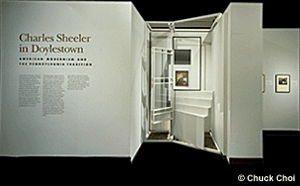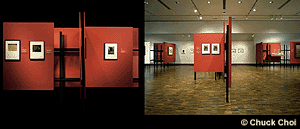 | ||

|
|
CLIENT Allentown Art Museum |
LOCATION Allentown, Pennsylvania COST Confidential |
|
|
DESCRIPTION
"Charles Sheeler in Doylestown: American Modernism and the Pennsylvania Tradition," which featured photographs and paintings by the early American Modernist master, required the creation of an exhibition venue within a large gallery space designed by Marcel Breuer. The installation would be freestanding because the gallery's concrete walls, which are interrupted by deeply canted recesses near each corner, could not be used for hanging artwork. Also, lighting strength would be restricted to five-foot candles to preserve the photographs. |
|
|
Upon entering the exhibition space, the visitor is met by a sculptural construction echoing Sheeler's well-known painting of a doorway opening onto a narrow spiral staircase. Painted stark white, the structure consists of a transparent door, composed of a wood frame with glass panels, and a set of planes that recall spiral stairs but unfold in a shallow, illusory space. Sheeler's actual painting, which is hung on the far wall, is precisely aligned with an empty doorframe above the stairs, so that the painting and the sculptural construction seem to merge into the same compressed space. The coordinate points of the painting to the construction orient the viewer within the exhibition space and establish its horizon line, or datum, at a five-foot eye-level. The construction also contains an introductory wall text.
|
|
|
Arrayed at right angles to each other across the length of the gallery, these structures create a floating series of intimately scaled spaces that guide the viewer through the exhibition. The corners and terminuses of the structures are exposed to reveal the supporting grid as well as the thin edges of the horizontal wall panels, which hang on either side of the framework. The wall panels are doubled even along the side facing the concrete back wall, and two panels projecting perpendicularly from the rear of the structure address the wall's canted recesses. Although the back panels and perpendicular projections are sensed more than they are seen, they add depth and structural consistency to the relationship between the installation and the original space.
|

